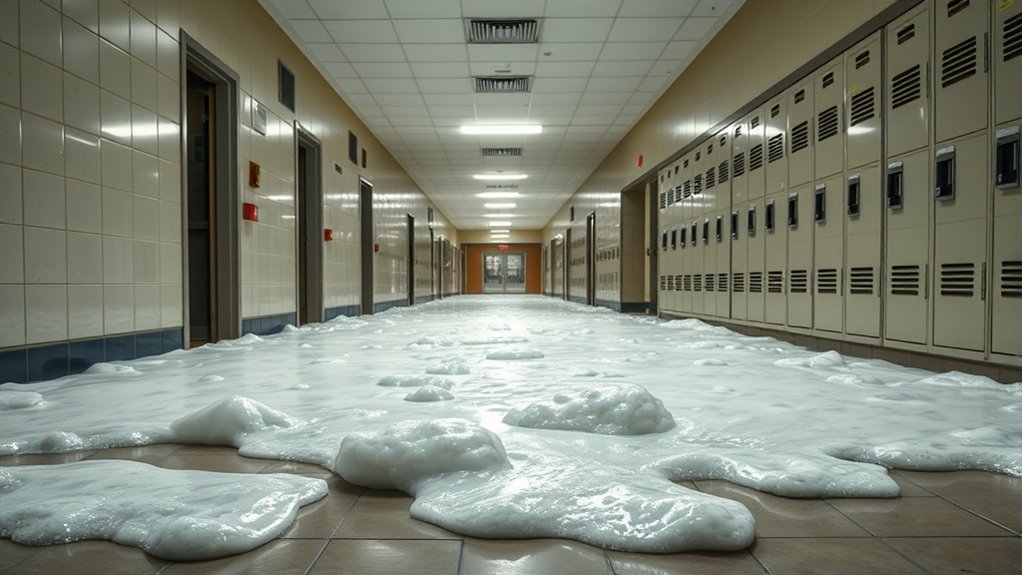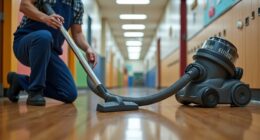Foam in recovery tanks near school hallways often results from chemical reactions and equipment issues, like worn valves or improper mixing. Surfactants in cleaning agents can cause bubbles to form and expand rapidly, leading to spills. Regular maintenance, such as cleaning components and checking for leaks, helps prevent foam overflow. Using defoamers and maintaining proper chemical ratios also manage foam levels effectively. Keep exploring to discover how precise procedures can keep your environment safe and mess-free.
Key Takeaways
- Properly balanced chemical mixtures and addition of defoamers prevent excessive foam in recovery tanks.
- Regular inspection and maintenance of equipment ensure proper functioning and reduce foam overflow risks.
- Surfactants in cleaning agents lower surface tension, so using appropriate chemical ratios minimizes foam formation.
- Troubleshooting equipment issues like clogged valves or leaks helps control foam buildup in hallways.
- Implementing preventative strategies, including proper chemical handling and equipment checks, maintains a safe, foam-free environment.

Have you ever wondered what’s causing foam to spill into school hallways? It might seem like a strange problem, but it all comes down to chemical reactions happening within your recovery tanks. When cleaning chemicals are mixed or stirred improperly, they can produce foam that quickly overflows, especially if the equipment isn’t maintained regularly. This foam often finds its way out of the tanks and into the hallways, creating a mess and potential safety hazards. Understanding the root causes involves recognizing how chemical reactions work in these systems and ensuring your equipment is in top shape.
Chemical reactions are at the core of foam formation in recovery tanks. Many cleaning agents contain surfactants, which lower the surface tension of liquids and allow bubbles to form more easily. When these chemicals combine or are agitated during operation, they create a foam that can be difficult to control. If the reaction occurs too vigorously or if the mixture is improperly balanced, the foam can expand rapidly beyond the tank’s capacity. That’s why monitoring chemical levels and mixing ratios is essential. It’s not just about adding chemicals but understanding how they interact within the tank environment. Miscalculations or using incompatible substances can trigger excessive foam, leading to spills into hallways.
Chemical reactions in recovery tanks can cause foam spills if not properly monitored and balanced.
Equipment maintenance plays an important role in preventing these foam spills. Over time, valves, seals, and other components can wear out or become clogged, disrupting the normal flow and mixing of cleaning agents. When equipment isn’t functioning properly, it can cause inconsistent agitation or pressure buildup, which promotes vigorous foam formation. Regular inspection and maintenance ensure that your recovery tanks operate smoothly. This includes cleaning filters, checking for leaks, and calibrating mixing mechanisms. A well-maintained system reduces the likelihood of unexpected foam overflow, saving you from messy hallways and potential safety issues.
Additionally, proper maintenance helps you identify early signs of trouble—such as unusual noises or pressure fluctuations—that could lead to foam spills if ignored. Incorporating routine checks into your maintenance schedule keeps your equipment in prime condition and prevents the chemical reactions from going out of control. When your system is working correctly, foam remains contained within the recovery tank, and you avoid the costly and disruptive process of cleaning up spills in school hallways.
Furthermore, understanding how equipment components and their proper functioning influence foam formation allows for better troubleshooting and preventative strategies.
In essence, controlling foam in recovery tanks boils down to managing chemical reactions carefully and maintaining your equipment diligently. When you understand how these factors intersect, you can implement effective defoaming strategies. Using the right defoamer, adjusting chemical ratios, and sticking to a regular maintenance routine help keep foam under control. This way, you ensure a safer, cleaner environment for everyone and avoid the chaos that foam spills can cause in your school.
Frequently Asked Questions
What Are the Long-Term Effects of Foam Buildup in Recovery Tanks?
Long-term foam buildup can cause tank corrosion and equipment malfunction. As foam accumulates, it creates a corrosive environment that damages the tank’s surfaces, weakening its structure. This buildup can also clog or impair equipment, leading to frequent malfunctions and costly repairs. Regular maintenance and using proper defoamers help prevent these issues, ensuring your recovery tanks stay in good condition and operate smoothly over time.
Can Certain Cleaning Products Prevent Foam Formation in Tanks?
Imagine your recovery tank as a calm lake; certain cleaning products, when chosen carefully, prevent foam formation by controlling chemical interactions and ensuring product compatibility. Using compatible cleaners minimizes foam-causing reactions, keeping the tank clear. Always select products designed for your system, checking labels and testing small amounts first. This proactive approach helps maintain smooth operations, reduces cleanup, and extends the life of your equipment.
How Often Should Foam Levels Be Checked in School Hallways?
You should check foam levels in school hallways’ recovery tanks daily as part of your foam maintenance routine. Regular inspections ensure foam isn’t building up excessively, preventing overflow or safety hazards. Follow safety protocols during these checks, wearing protective gear if necessary. Consistent monitoring helps maintain safe, efficient cleaning operations and extends equipment longevity. Make it a daily habit to identify issues early and keep your environment safe for everyone.
Are There Environmentally Friendly Defoamers Available for School Use?
Think of eco-friendly solutions as the gentle giants of defoamers—you’ll find biodegradable options designed for school use. Yes, there are environmentally friendly defoamers available, crafted to minimize ecological impact while controlling foam effectively. These biodegradable options not only keep your hallways safe but also align with sustainability goals. Using such products guarantees you’re protecting the environment while maintaining a clean, safe school environment for everyone.
What Training Is Recommended for Staff Handling Foam-Related Issues?
You should provide staff training focused on foam safety to guarantee they understand proper handling and response procedures for foam-related issues. This training should cover identifying foam hazards, using protective equipment, and applying defoamers effectively. Regular refresher courses are essential to keep everyone updated on best practices. Well-trained staff can prevent accidents, minimize foam buildup, and maintain a safe environment during foam management in school hallways.
Conclusion
While foam in school hallways might seem like a minor nuisance, it highlights a larger challenge—balancing cleanliness with safety. Defoamers act as both solution and reminder that even small issues can disrupt daily life, forcing us to address them quickly. In a way, foam is like chaos in disguise—messy yet manageable. By understanding and controlling it, you restore order, proving that sometimes, the tiniest problems demand the biggest attention.








